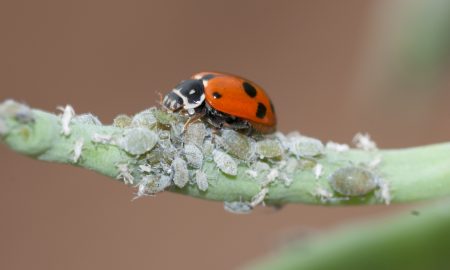A fifth winter cropping season with the Russian wheat aphid in the southern region is underway, reports to PestFacts south-eastern indicates low activity and researchers are in a better position to make predictions about future aphid infestation risk.
Season update
During late autumn and early winter this year, the PestFacts south-eastern team has received reports of Russian wheat aphid (Diurpahis noxia) in most cereal cropping regions in Victoria and southern New South Wales.
To date, sightings have mostly been from volunteer and early sown crops, and we are yet to hear of concerning populations, except one report of numbers approaching threshold levels in early sown wheat in East Gippsland.
If you are seeing otherwise, or in fact, any Russian wheat aphid populations in general, report it to our team (pestfacts@cesaraustralia.com) to help us ground truth the following research:
Predictions from green bridge surveillance
Targeted Russian wheat aphid surveillance undertaken since 2018 as a part of the GRDC investment ‘RWA Regional Risk Assessment and Regional Thresholds’ has now concluded.
The large dataset developed from this surveillance has allowed researchers from cesar and SARDI to dig deeper into the ecology of Russian wheat aphid, such as identifying what environmental factors are important for this aphid to survive in the green bridge in the lead up to autumn migratory behaviour – a key factor in infestation risk for winter sown cereals.
For most grain growing regions where this aphid has been observed, populations grow within cultivated crops over the winter, then disperse during a spring migration into refuges to ‘over-summer’, and then re-disperse back into emerging crops during an autumn migration.
Persistence of Russian wheat aphid in the green bridge has been found to be associated with moderate temperatures (<20°C), low to moderate available soil moisture (5% in top 0-10 cm), with migration occurring when daily maximum temperatures exceed 24°C. During targeted surveillance the presence of irrigated crops increased the likelihood of Russian wheat aphid detection.
Understanding the factors that increase chance of aphid survival has supported development of a forecasting tool that predicts where suitable climatic conditions for supporting Russian wheat aphid remain highest over October to April. The model forecast therefore predicts the locations where Russian wheat aphid would be most likely to persist and more readily colonise winter sown crops.
Despite regional variation, refuge risk was predicted overall to be low across southeastern grain growing areas during 2018-19 and 2019-20. These predictions assume no irrigation, and as such, presence of irrigation is expected to increase risk above predicted levels.
The model confirms that prior to the 2019 growing season there was a poor green bridge for Russian wheat aphid, while the prediction for 2020 shows that some locations in northern Victoria as well as the southern Mallee region remained comparatively suitable over the green bridge (Oct 2019 – April 2020) and these areas in particular should be monitored for Russian wheat aphid activity, along with areas that had persistent summer irrigation allowing for more aphid persistence across the summer and into the winter cropping season.
Similar to 2019, Russian wheat aphid populations are expected to once again be low across most of the known Russian wheat aphid range in 2020.

Map by James Maino, Cesar Australia 
Map by James Maino, Cesar Australia
Management insights
More broadly this research has shown that even when the aphid is consistently present in the environment they rarely naturally infest winter sown cereal crops, and when they do there is still not a strong risk of yield loss.
Therefore, the annual use of insecticide seed treatment against Russian wheat aphid does not appear on the whole to be a cost-effective option and adds to the risk of insecticide resistance emerging in other species.
Instead, a combination of autumn monitoring when crops are emerging and the use of economic thresholds to determine cost effectiveness of intervention is the recommended management strategy.
Exceptions to the expected cost inefficiency of prophylactic seed treatments to manage Russian wheat aphid may be areas where high populations of grasses frequently persist over summer through irrigation: irrigated grass paddocks, irrigated orchards, and maybe some summer cereals.
Hosts to keep an eye on during monitoring
Throughout these surveys, Russian wheat aphid were found over-summering in a variety of grassy weeds and volunteer cereal crops. The highest preferred weed was barley grass, which appeared to be just as palatable for Russian wheat aphid as volunteer cereal crops, followed by Brome grasses (incl. prairie grass), rye grass, Phalaris and wild oat. These weed hosts frequently show none of the outward symptoms of Russian wheat aphid colonies which are common in cultivated crops (just as leaf rolling and streaking).
You can learn how to identify Russian wheat aphid in this Pest Bites episode.
For further details on this research, view the latest autumn report.
Acknowledgments
Thanks to the following for providing field observations: Elia Pirtle (cesar), Michael Harris (AGnVET), Darcy Bullen (Western Ag), Michael Nash, Barry Haskins (Ag Grow Agronomy), Andrew McMahen (Nutrien Ag Solutions), Matt Witney (Dodgshun medlin), Simon Mock (Clovercrest Consulting), Piotr Trebicki (Agriculture Victoria), Cameron Morris (Nutrien Ag Solutions).
Contributions to this article were made by Dr Elia Pirtle and Dr James Maino.
Cover image: Photo by Elia Pirtle, Cesar Australia





